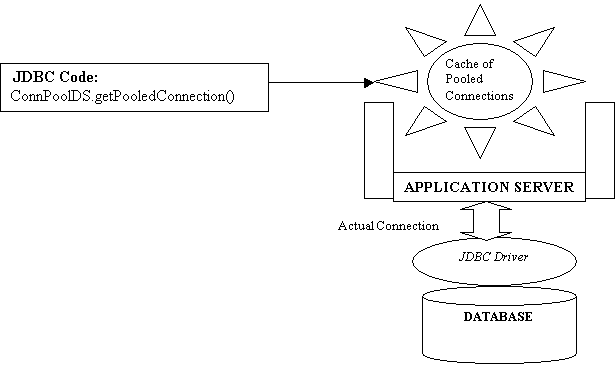Weblogic.jdbc.wrapper.poolconnection Oracle Jdbc Driver T4cconnection Mn

Passing oracle.sql.ARRAY to a Stored. Oracle.jdbc.driver. Exfo Otdr Trace Viewer Software. T4CConnection at weblogic.rjvm. How to Connect to WebLogic DataSource from a Java.
JDBC Deadlock in ORACLETIMEOUTTHREADPERVM and T4CCONNECTION when Using JDBC 11.2 with WebLogic 10.3 or 12.1 (Doc ID 1423425.1) Last updated on MARCH 08, 2017 Applies to: JDBC - Version 11.2.0.2.0 to 11.2.0.3.0 [Release 11.2] Oracle WebLogic Server - Version 10.3.4 to 12.1.2.0.0 Information in this document applies to any platform.
Using API Extensions to JDBC Interfaces Some database vendors, including Oracle, provide additional proprietary methods for working with data from a database that uses their DBMS. These methods extend the standard JDBC interfaces. WebLogic Server supports all extension methods exposed as a public interface in the vendor's JDBC driver. To use the extension methods exposed in the JDBC driver, you must include these steps in your application code: • Import the driver interfaces from the JDBC driver used to create connections in the data source. • Get a connection from the data source.
• Cast the connection object as the vendor's connection interface. • Use the API extensions as described in the vendor's documentation. • The JNDI lookup is wrapped in a try/catch block in order to catch a failed look up and also that the context is closed in a finally block. The following sections provide details in code examples. For information about specific extension methods for a particular JDBC driver, refer to the documentation from the JDBC driver vendor. Using API Extensions for Oracle JDBC Types When Oracle implemented JDBC, concrete classes were used instead of using interfaces for Oracle JDBC Types.
There are many of drawbacks in using concrete classes and in the 11.2.0.3 driver there are new interfaces corresponding to the Oracle types. The concrete classes now implement a public interface from the package oracle.jdbc. Programmers should use methods exposed in java.sql whenever possible and for Oracle extension methods use oracle.jdbc. In the mean time, WebLogic Server implemented corresponding interfaces that could be used to work around the limitations of the concrete classes. These are now deprecated and should be replaced with the corresponding oracle.jdbc interfaces. In Database version 11.2.0.3 the following types have interfaces. Using Deprecated API Extensions with the Oracle Thin Driver For most extensions in the Oracle Thin driver, you can use the standard technique as described in.
Special Considerations When Using Oracle Thin Driver Extensions Please note the following limitations when using Oracle Thin driver extensions to JDBC interfaces: • You can use Oracle extensions for ARRAYs, REFs, and STRUCTs in server-side applications that use the same JVM as the server only. You cannot use Oracle extensions for ARRAYs, REFs, and STRUCTs in remote client applications.
• You can create ARRAYs and STRUCTs in your applications by using a non-standard Oracle descriptor object. • You can execute queries against a table that contains REF to Oracle Object types and the REF is materialized as a Java oracle.sql.REF object by JDBC. JDBC does not support creating new REF from scratch. Go to the database and insert the new REF in SQL, select the REF, and return it to the client.
• There are interoperability limitations when using different versions of WebLogic Server clients and servers. Note: In the JDBC 4.0 API, the following java.sql.Connection can be used to create STRUCT and ARRAY objects in applications without a descriptor. •: When creating a SQL structure using Connection.createStruct(), it is necessary to unwrap all data types ( java.sql.Clob, java.sql.Blob, java.sql.Struct, java.sql.Ref, java.sql.Array, java.sql.NClob, and java.sql.SQLXML). Once the structure is created, there is no way to re-wrap them before returning the structure to the application. The structure returned to the application has unwrapped values for the data types. •: The SQL specification requires anonymous array types.
Create an array type in the database with a name before using the array. You cannot create an array from the client side. Sample Code for Accessing Oracle Thin Driver Extensions to JDBC Interfaces The following code examples show how to access the WebLogic Server interfaces for Oracle extensions that are not available as public interfaces prior to 11.2. Ammyy Admin 3.1 For Xp more. 0.3. Msts - Addon - Dieselswest Emdx Sd60 Locomotive Set Load. , including interfaces for: • ARRAYs—See. • STRUCTS—See.
• BLOBs and CLOBs—See. If you selected the option to install server examples with WebLogic Server, see the JDBC examples for more code examples, typically at WL_HOME samples server src examples jdbc, where WL_HOME is the folder where you installed WebLogic Server.